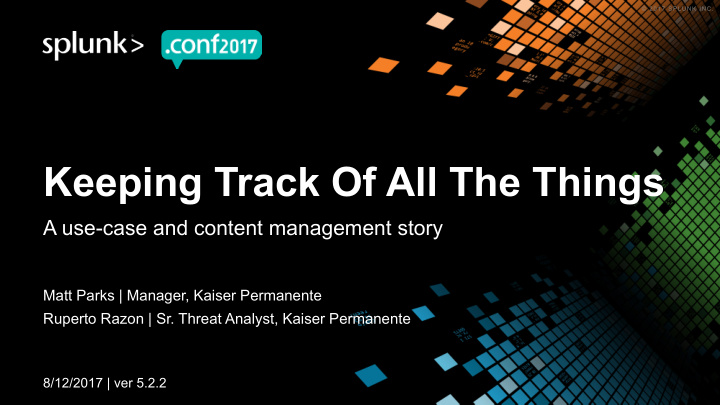



Keeping Track Of All The Things A use-case and content management story Matt Parks | Manager, Kaiser Permanente Ruperto Razon | Sr. Threat Analyst, Kaiser Permanente 8/12/2017 | ver 5.2.2
Our Purpose ▶ Share our lessons learned in consolidating artifacts of our migration from a previous SIEM to our current SIEM/logging solution ▶ Describe the process our team developed to manage our security use-case and content development efforts ▶ Provide you some answers to a few familiar questions
What Questions? These Questions What does our security coverage look like, from a use-case perspective? Bob in accounting was infected by <insert-threat-of-the-day-here>, who else was infected? How are we tracking towards our high level security goals for the year? What does your development team do all day?
Who are you guys? Matt Parks Manager, Security Analytics, Cyber Risk Defense Center ▶ Matthew.Parks@kp.org ▶ linkedin.com/in/matthewparks
Who are you guys? Ruperto Razon Sr. Threat Analyst, Security Analytics, Cyber Risk Defense Center ▶ Ruperto.S.Razon@kp.org ▶ linkedin.com/in/PertoRazon ▶ @thatperto
Cyber Risk Defense Center (CRDC)
Advanced and Actionable Intelligence MODIFIED KILL Reconnaissance Exploitation Lateral Movement Reach Objective CHAIN TEAMS Threat Intelligence Infiltration Lateral Movement Data Exfiltration • Network DLP • Threat Feeds (paid, • Endpoint Security Devices • Malware Detonation TOOLS • Endpoint DLP Open Source, Internal) • OS Logging • Network Intrusion • Email DLP • Contextual Information • User modeling Detection and Prevention • PCAP data (Virus Total, whois, etc.) • PCAP data • Endpoint Security • Cloud Security • Farsight • SMTP Gateways technology • Industry Relationships • Layer 7 Detection and • Law Enforcement Prevention DATA Splunk Other Big Data Platforms LAYER ACTIONABLE INTELLIGENCE
Let ’ s start from the middle…. Pre-Migration (Summer 2015) Migration Complete (Spring 2016) ▶ 2TB+ data/day ▶ 4TB+ data/day ▶ 128 Threat Use-Cases ▶ 43 Threat Use-Cases ▶ 60 Scheduled Reports ▶ 33 Scheduled Reports ▶ 652 “Knowledge Objects” ▶ 121 Knowledge Objects ▶ 15+ Documentation Repositories ▶ 4 Documentation Repositories
Where We Are Today ▶ 8+TB data/day ▶ 60+ distinct sourcetypes ▶ 75+ Custom Threat Use-Cases ▶ 100+ Scheduled Reports/Dashboards/Form Searches
Documentation…
Artifacts of Note ▶ Naming conventions ▶ Asset Categories ▶ Search logic ▶ Recipients/Users ▶ Knowledge objects ▶ Original Requestor ▶ Scheduling of searches/reports ▶ Tribal Knowledge
Scrum in 100 Words • Scrum is an agile process that allows us to focus on delivering the highest business value in the shortest time. • It allows us to rapidly and repeatedly inspect actual working software (every two weeks to one month). • The business sets the priorities. Teams self-organize to determine the best way to deliver the highest priority features. • Every two weeks to a month anyone can see real working software and decide to release it as is or continue to enhance it for another sprint.
What does a Scrum look like?
The Scrum Advantage
Scrum Framework Process
Example Story
So what do we do with all this JIRA Data? Improve situational awareness Visualize our JIRA activity Improve our development process Answer questions
Bob in accounting was infected by <insert-threat- of-the-day-here>, who else was infected?
Anyone heard of Wannacry? ▶ 14 separate JIRA Stories • 3 new Correlation Searches • 6 Research Stories • 2 Tuning Requests • 3 Stories for Follow-up/Remediation
What does our security coverage look like, from a use- case perspective?
Deployed Use-Case Visibility
Searches! Note: <insertyourdatahere> ▶ SA Visualization Dashboard • Enabled Correlation Search Breakdown by Team • |rest /services/alerts/correlationsearches splunk_server=local | rename eai:acl:app as application, title as csearch_name |join type=outer app csearch_name [rest /services/saved/searches| rename eai:acl:app as application, title as csearch_name, search as csearch|table app, csearch_name, csearch, disabled]|eval status=if(disabled==1,"Disabled","Enabled") | search status=Enabled | eval splitdes = split(rule_title, "-"), designation = mvindex(splitdes, 0) |table designation security_domain, rule_title, csearch_name, description, severity, csearch, disabled, status | stats count by designation | sort –count • Enabled Correlation Search Breakdown by Severity • |rest /services/alerts/correlationsearches splunk_server=local | search rule_title!="" | rename eai:acl:app as application, title as csearch_name |join type=outer app csearch_name [rest /services/saved/searches| rename eai:acl:app as application, title as csearch_name, search as csearch|table app, csearch_name, csearch, disabled]|eval status=if(disabled==1,"Disabled","Enabled") | search status=Enabled | eval splitdes = split(rule_title, "-"), designation = mvindex(splitdes, 0) |table designation security_domain, rule_title, csearch_name, description, severity, csearch, disabled, status | eval Severity=case(severity=="critical","1-critical", severity=="high","2-high", severity=="medium","3-medium", severity=="low","4-low", severity=="informational","5-informational") | stats count by Severity
Searches! Note: <insertyourdatahere> ▶ SA Visualization Dashboard (cont.) • Use Case Count by Team / Severity • |rest /services/alerts/correlationsearches splunk_server=local | rename eai:acl:app as application, title as csearch_name |join type=outer app csearch_name [rest /services/saved/searches| rename eai:acl:app as application, title as csearch_name, search as csearch|table app, csearch_name, csearch, disabled]|eval status=if(disabled==1,"Disabled","Enabled") | search status=Enabled | eval splitdes = split(rule_title, "-"), designation = mvindex(splitdes, 0) | table designation rule_title description, severity, status | eval Severity=case(severity=="critical","1-critical", severity=="high","2-high", severity=="medium","3-medium", severity=="low","4-low", severity=="informational","5-informational") | chart count as "Rule Count" by designation, Severity • Changes in Triggered Notable Events - Past 30 Days - by Correlation Search • `notable` | search search eventtype!=notable_suppression* | bin _time span=24h |stats count by _time, search_name | streamstats window=2 global=f current=t first(count) as previous by search_name | eval delta=count-previous | eval time=_time | table search_name, time, delta, count • Enabled Use Case – Details • |rest /services/alerts/correlationsearches splunk_server=local | search rule_title!="" | rename eai:acl:app as application, title as csearch_name |join type=outer app csearch_name [rest /services/saved/searches| rename eai:acl:app as application, title as csearch_name, search as csearch|table app, csearch_name, csearch, disabled]|eval status=if(disabled==1,"Disabled","Enabled") | search status=Enabled | eval splitdes = split(rule_title, "-"), designation = mvindex(splitdes, 0) |table designation rule_name description, severity, status | sort designation, rule_name
Recommend
More recommend